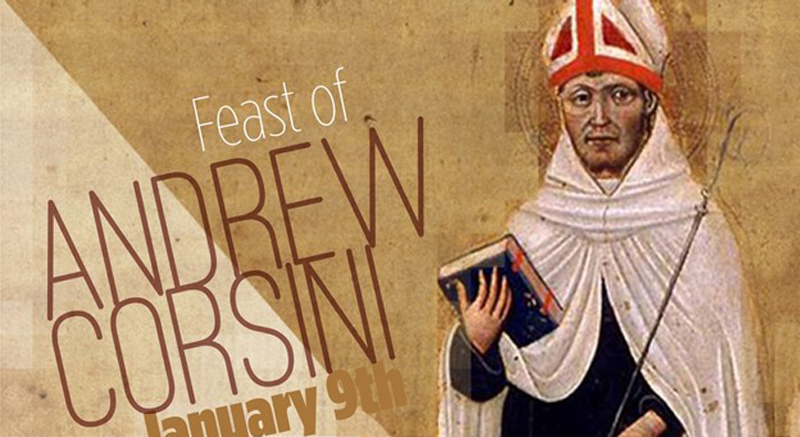(Died 1374)
Andrew Corsini was born in Florence at the beginning of the 14th century, one of the 12 children of Nicholas Corsini and Gemma degli Stracciabende.
By 1338, he was associated with the convent of Carmel in Florence. In 1343, he was mentioned in a contract between the religious and the Company of the Battuti. In the 1344 chapter of the Tuscan province, he was appointed a counselor of the convent of Florence. In June of 1347, besides being confirmed as a counselor, he was named a lector of the same convent.
While in France in 1348 for the general chapter of the Order at Metz, he was made superior of the Tuscan province, an office that he filled until the first days of 1350, even after his nomination as bishop of Fiesole. Among the challenges of his early years in this office were dealing with the repercussions of the black plague and the building of the church of Carmel. In January of 1350 he gave an exact account of all expenses for the construction. By that time Pope Clement VI had named Corsini bishop of Fiesole (a town on a hill overlooking Florence).
The first recorded act of Andrew’s was in March 1350. Andrew broke the tradition of more than a century, according to which the bishops of Fiesole resided in Florence, next to the church of St. Mary in the Field. He wanted to remain near his people, near his cathedral, which was threatening ruin, and in his episcopal palace, even though this needed repairs and furnishings. He restricted his needs to the most indispensable; he reduced to six the number of his attendants, and with these and two religious of Carmel he led a monastic life.
He wore the Carmelite habit and carried a small iron chain around his waist (still preserved today). Scrupulously exact, he himself kept the accounts of administration of the house, of the episcopal table, and of the contributions to the Pope. He accounted for and directed the various works of the churches and hospitals. The servants themselves entrusted to him the amounts scraped together during their time of service.
He reclaimed for himself the granting of ecclesiastical benefices but kept them free of any kind of trafficking. He insisted that the beneficiaries have holy orders. He was particularly scrupulous regarding the conduct of the clergy, which left much to be desired: ignorance, bad habits, gambling, secular clothes. Some clerics were obliged to present themselves within a certain time, to be reexamined; in no way did he tolerate the clerics who failed in their obligation of chastity. Also, a short length of time was allowed to those who did not reside in their parishes; and if they did not return, they were punished by the revocation of their benefice.
For having a better clergy in the future, he instituted, in 1372, a confraternity of priests who would contribute, by their example and works, to the scientific and moral formation of future priests. To his personal example he added the ministry of preaching, so that one of the praises engraved on his tomb could call him “marvelous by the example of his life and his eloquence.”
No less was his care in helping the needy. He defined himself as “the father and administrator of the poor.” And the poor were not lacking, especially during his first years as bishop, in consequence of the plague of 1348-49. In fact, it is precisely a regulation on their behalf that on March 28, 1350, he emanated the first documented act of his episcopate. He was demanding in claiming the income of pious legacies, because it was necessary for the poor (to whom he gave “for the love of God”) and for the restoration and furnishing of various churches. He also exercised a strict vigilance over the income destined for the sick and for pilgrims.
Andrew was renown for his ability to justly settle disputes. Ecclesiastics and rich merchants of Florence and Fiesole, powerful citizens of Prato, Pistoia and other cities went to him as to an impartial and incorruptible arbiter. Not so well documented is the mission of peace with which he is said to have been charged by the Pope in the city of Bologna when this city was restored to the obedience of the Pope, against the intrigues of the Viscounti of Milan. Del Castagno reports it from the account given in Florence by Cardinal Albergati.
Andrew died on Jan. 6, 1374. Twelve years after being laid in his tomb, still incorrupt, the body was placed in the monument erected by the relatives of the saint in the church of Carmel. This monument was destroyed in a fire of 1771 (though the body was able to be saved); but it was entirely like that of his brother Neri, still preserved today in the cloister of the Holy Spirit.
Adapted by A. J. Valentini from: St. Andrew Corsini, Bishop (Feast) | The Website of the Carmelite Order | Welcome. (n.d.). The Carmelite Order. Retrieved December 30, 2020, from https://ocarm.org/en/content/liturgy/st-andrew-corsini-bishop-feast
